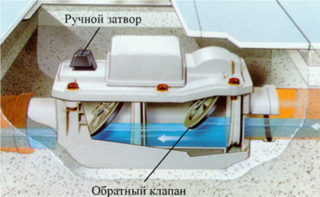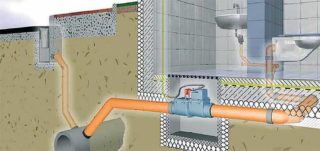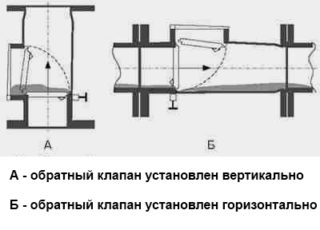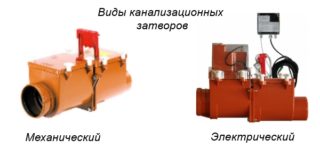In large multi-storey buildings, a very serious problem for residents is the blockage of the sewer riser, leading to the discharge of all sewage through the first toilet bowl or bath located above the blockage. Moreover, if a blockage occurs in the daytime, when residents are actively using the sewage system, a large volume of drains pouring out through the toilet can seriously flood the apartment, lead to damage to the floor and furniture, high humidity, and an unpleasant odor. A sewer shutter will help to avoid such a situation.
Definition and purpose of the device

The sewer valve is a reliable and simple check valve used in the sewer systems of high-rise buildings and cottages. Consists of the following parts:
- PVC case with removable top cover;
- a bell with a sealing rubber, located on the side of the connected plumbing fixture;
- 1 or 2 round petal flaps located inside the body and opening only in one direction;
- Forced-close valve handle for locking the petals when closed.
The main functions of the shutter:
- Prevention of backflow of drains in sewer systems in the event of blockages - the petals of the device, opening in one direction, easily pass sewage into the riser. When a blockage forms, the petals close and do not allow the drain from the upper floors to come out through the toilet, bath drain holes, sinks, washbasins.
- Protecting living quarters from unpleasant sewage odors - a sewer check valve, which is closed most of the time, prevents it from entering.
- Preventing rats and other rodents from entering the apartment through the sewer pipes - the valve flap closed in the absence of water flow blocks their path.
In cottages and private houses, such a gate contains a yard sewage system, which avoids flooding of the bathroom, bathroom and living quarters with fecal and wastewater when the nearby city collector is clogged.
Principle of operation
The principle of operation of the most common two-chamber mechanical shutter in apartment buildings is as follows:
- In the absence of water flow, two petals located one behind the other are in the closed position.
- When the flow appears, the dampers open under its pressure, closing after weakening.
- In the event of a blockage and reverse flow of wastewater from the riser into the apartment sewage system, two petals reliably block the path of the mass of water and prevent it from pouring out through the toilet or bathroom drain.
The great popularity of two-chamber sewer gates is due to their reliability - even if 1 petal fails and passes water, a less worn out and more reliable gate will not allow it to penetrate further.
Types of closures
- Horizontal - parallel to the floor and connected to the riser at a right angle.
- Vertical - installed directly into the vertical riser and are part of it.
Depending on the number of damper blades, there are:
- Single-chamber shutter - equipped with one shutter. A typical representative of such devices is a simple dry sewerage seal installed in a special drain - an opening for water discharge in the concrete floor of basements and heating points of high-rise buildings.The ladder allows you to efficiently and quickly drain flooded basements without the use of drainage pumps.
- Two-chamber mechanical or electrical shutter - has two shutters located one after the other. One of them can be fixed in the closed position using a handle or an electric drive.
- Mechanical shutter - the shutter is opened and closed under the action of water pressure.
- Sewer gate with electric drive - the dampers are opened and closed using a special electric drive. This happens when 70% of the volume of the working chamber between the two dampers is filled with a reverse flow of water - while the sensor inside the chamber sends a signal to the control unit, which gives a command to the actuator to close the dampers.
Criterias of choice
When choosing a sewer check valve, the following criteria are taken into account:
- Terms of use - single-chamber inexpensive sewer check valves are suitable for intra-apartment sewage; more expensive and high-quality models are used for the basement.
- Type of plumbing fixtures to be connected - valves with an inner diameter of 50 mm are used for the kitchen sink, washbasin. The toilet bowl and the bathroom are connected to the riser by a sewer valve with an internal passage of 110 mm. A two-chamber check valve with an electric drive and an internal diameter of at least 160 mm is installed on the main pipeline and the yard sewage system. In this case, the device is placed in a dry inspection well, which has a high, reliable head and a convenient hatch.
Installation features

The installation process of a horizontal sewer valve using the example of connecting to a toilet is as follows:
- The old pipe connecting the toilet bowl to the riser is dismantled.
- A flexible corrugation is put on the release of the toilet.
- The other end of the corrugation is inserted into the flare of the valve.
- The end of the shutter opposite the bell is inserted into the branch of the crosspiece on the riser.
- To seal the joints and simplify installation, use socket grease or sanitary silicone.
The shutter installed in this way will reliably protect the apartment from flooding with sewage.
The only drawback of such devices from the point of view of the layman is their tangible cost - a simple single-chamber mechanical shutter with an inner diameter of 110 mm costs about 2000 rubles. However, the one-time costs of buying a valve are much less than the costs of eliminating the consequences of flooding an apartment with drains, such as repair or complete replacement of floors, re-pasting wallpaper, and buying new plumbing fixtures.










